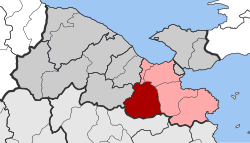Tenea
|
Tenea Τενέα |
|
|---|---|
| Coordinates: 37°48′N 22°52′E / 37.800°N 22.867°ECoordinates: 37°48′N 22°52′E / 37.800°N 22.867°E | |
| Country | Greece |
| Administrative region | Peloponnese |
| Regional unit | Corinthia |
| Municipality | Corinth |
| • Municipal unit | 167.6 km2 (64.7 sq mi) |
| Elevation | 290 m (950 ft) |
| Population (2011) | |
| • Municipal unit | 5,084 |
| • Municipal unit density | 30/km2 (79/sq mi) |
| Time zone | EET (UTC+2) |
| • Summer (DST) | EEST (UTC+3) |
| Postal code | 200 08 |
| Area code(s) | 27410 |
| Vehicle registration | ΚΡ |
Tenea (Greek: Τενέα) is an ancient city and a former municipality in Corinthia, Peloponnese, Greece. Since the 2011 local government reform it is part of the municipality Corinth, of which it is a municipal unit. The municipal unit has an area of 167.575 km2. The seat of the municipality was in Chiliomodi. Ancient Tenea was established approximately 15 kilometres SE of Corinth and 20 kilometres NE of Mycenae shortly after the Trojan War. It is believed that the first inhabitants were Trojans prisoners of war to whom Agamemnon permitted to build their own town. Hence the name Tenea resembles that of Tenedos, their home-town. Tenea and Rome, according to the Aeneid of Virgil, are two historical cities known to be associated with Trojan ancestry following the Trojan War. Corinthians and Teneans in 734 or 733 BC under the leadership of Archias established the joint colony of Syracuse in Sicily, the homeland of Archimedes.
Mention of Tenea was made by Strabo
and Pausanias
Ruins of Tenea can still be found one kilometre south of Chiliomodi. Some of the archaeological findings are located today in the Archaeological Museum of Ancient Corinth. The most famous finding, the statue from Tenea, known as Kouros of Tenea (c. 550 BC), which was found near Athikia in 1846, today stands in the Glyptothek of Munich. It is a great example of the 6th century BC Greek sculpture and also example of the so-called Aeginetean or archaic smile.
...
Wikipedia


